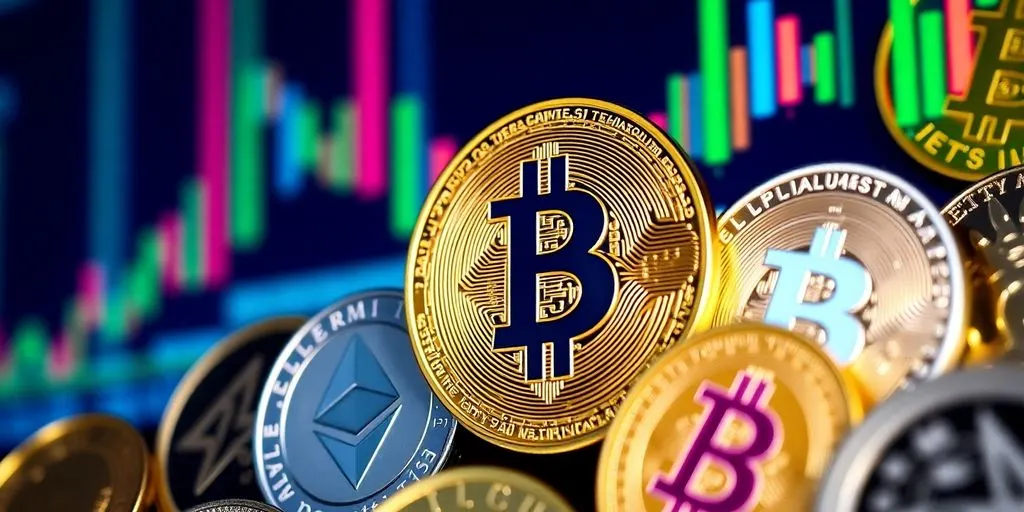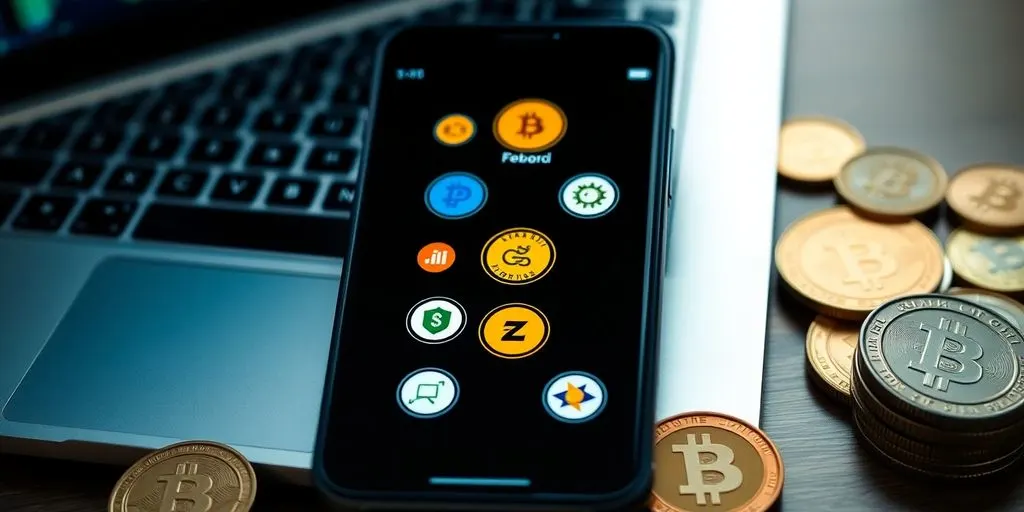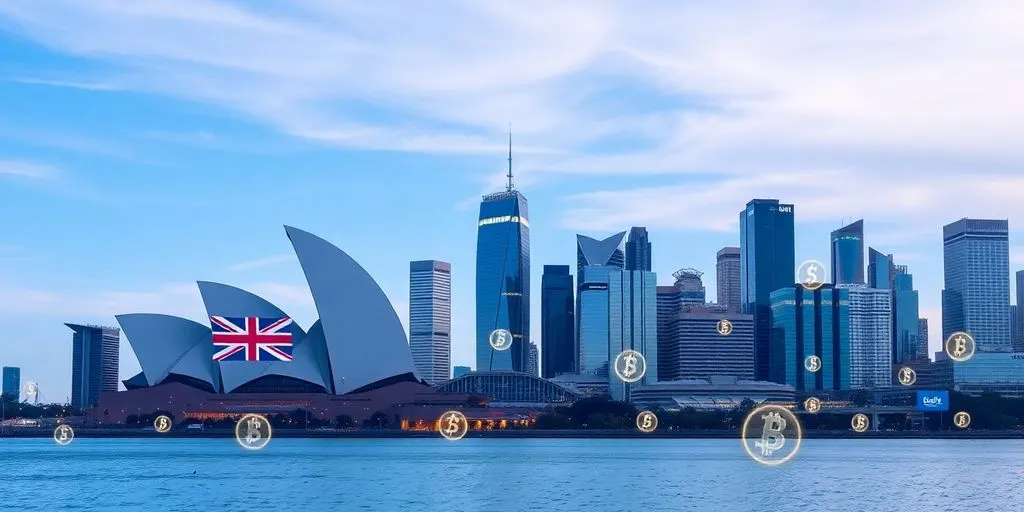If you’re looking to jump into the world of digital currencies, you’ve come to the right place. This guide covers everything you need to know about how to invest in cryptocurrency in Australia, especially if you’re just starting out.
From understanding the basics to picking the right exchange and managing your investments, we’ll break it down in simple terms. Let’s get started!
Key Takeaways
- Learn the basics of cryptocurrency and blockchain technology before investing.
- Choose a reputable Australian exchange that suits your needs.
- Understand how to fund your account and the importance of KYC regulations.
- Diversify your crypto portfolio to manage risk effectively.
- Stay updated on market trends and tax obligations related to your investments.
Understanding Cryptocurrency Basics

What Is Cryptocurrency?
Okay, so what is cryptocurrency anyway? Well, simply put, it’s digital money. It’s like the internet’s version of cash, but instead of physical coins or notes, it exists as code.
Think of it as entries in a digital ledger. Cryptocurrencies use cryptography to secure transactions and control the creation of new units. Unlike traditional currencies issued by central banks, many cryptocurrencies operate on decentralized networks, meaning no single entity controls them.
Cryptocurrencies are digital assets that hold value, similar to how physical currency represents a specific monetary value.
How Does Blockchain Technology Work?
Blockchain is the backbone of most cryptocurrencies. It’s a distributed, decentralized, public ledger that records all transactions. Imagine a chain of blocks, where each block contains a set of transactions.
Once a block is added to the chain, it cannot be altered, making the blockchain incredibly secure and transparent.
Here’s a simplified breakdown:
- Transactions are grouped into blocks.
- Each block is linked to the previous block using cryptography.
- The chain is distributed across many computers, making it resistant to tampering.
Blockchain’s transparency and security features are what make cryptocurrencies so appealing. It eliminates the need for intermediaries like banks, allowing for peer-to-peer transactions.
Types of Cryptocurrencies
Not all cryptocurrencies are created equal. There’s a whole zoo of them out there, each with its own unique features and purposes. Here are a few common types:
- Bitcoin (BTC): The OG cryptocurrency, often seen as a store of value.
- Ethereum (ETH): Known for its smart contract capabilities, enabling decentralized applications (dApps).
- Altcoins: Any cryptocurrency that isn’t Bitcoin. This includes a huge range of coins like Ripple (XRP), Litecoin (LTC), and Cardano (ADA), each with different goals and technologies. Some are trying to be faster payment systems, others are focused on privacy, and some are just plain weird. It’s a wild west out there, so do your research before investing in any crypto investment.
Choosing the Right Exchange
Alright, so you’re ready to jump into the world of crypto in Australia. Awesome! But before you start buying Bitcoin or Ethereum, you need a place to do it. That place is a crypto exchange.
Think of it like a stock exchange, but for digital currencies. Choosing the right one is important, so let’s break it down.
Comparing Australian Crypto Exchanges
There are a bunch of crypto exchanges available to Australians, each with its own pros and cons. Some are local, some are international, and they all have different features, fees, and security measures. It can be a bit overwhelming at first, but don’t worry, we’ll simplify it.
Here’s a quick rundown of some popular exchanges:
- CoinSpot: Known for its user-friendly interface, making it great for beginners.
- Binance Australia: A global giant with a wide range of cryptocurrencies and advanced trading options.
- Kraken: Another international exchange with a good reputation for security and lower fees.
- Independent Reserve: A well-established Australian exchange focused on security and compliance.
It’s a good idea to check out reviews and compare these exchanges before making a decision. See what other users are saying about their experiences.
Factors to Consider When Selecting an Exchange
Okay, so how do you actually choose an exchange? Here are some things to keep in mind:
- Fees: Exchanges charge fees for buying, selling, and withdrawing crypto. These fees can vary quite a bit, so it’s worth comparing them. Look for exchanges with competitive rates.
- Security: This is a big one. Make sure the exchange has strong security measures in place, like two-factor authentication (2FA) and cold storage for funds. You don’t want your crypto getting stolen.
- Cryptocurrency Selection: Does the exchange offer the cryptocurrencies you’re interested in buying? Some exchanges only offer a limited selection, while others have hundreds of different coins.
- Payment Methods: Can you easily deposit Australian dollars (AUD) into your account? Check if the exchange supports bank transfers, credit cards, or other convenient payment methods.
- User Interface: Is the exchange easy to use? A complicated interface can be frustrating, especially if you’re new to crypto.
- Customer Support: What’s the customer support like? If you run into any problems, you’ll want to be able to get help quickly.
Choosing an exchange is a personal decision. What works for one person might not work for another. Take your time, do your research, and pick an exchange that meets your needs and makes you feel comfortable.
How to Create an Account to Invest In Cryptocurrency in Australia
Once you’ve chosen an exchange, you’ll need to create an account. The process is usually pretty straightforward:
- Sign Up: Go to the exchange’s website and click on the “Sign Up” or “Register” button.
- Provide Information: You’ll need to provide some personal information, such as your name, email address, and date of birth.
- Verify Your Identity (KYC): Most exchanges are required to verify your identity under Australian regulations. This usually involves uploading a copy of your driver’s license or passport.
- Set Up Two-Factor Authentication (2FA): This adds an extra layer of security to your account. You’ll need to use an app like Google Authenticator or Authy to generate a unique code each time you log in.
- Deposit Funds: Once your account is verified, you can deposit Australian dollars (AUD) into your account using one of the supported payment methods.
And that’s it! You’re now ready to start buying and selling crypto.
Funding Your Crypto Account
So, you’ve picked an exchange, now what? Time to put some Aussie dollars in there so you can actually buy some crypto! It’s not as scary as it sounds, promise.
Methods to Deposit Australian Dollars
Okay, so most exchanges offer a few ways to get your AUD into your account. Bank transfers are super common – usually pretty quick, but sometimes they can take a day or two.
Some exchanges also let you use a debit or credit card, which is instant, but watch out for those fees! They can eat into your investment.
I’ve even seen some that take cash deposits at certain newsagents, which is kinda cool if you’re old school. Just check what your exchange offers and what the fees are before you commit. Y
ou can purchase cryptocurrency on Kraken using a debit card.
Understanding KYC Requirements
KYC, or “Know Your Customer,” is basically the exchange making sure you are who you say you are. Think of it like showing your ID at a bar. They’ll usually ask for a copy of your driver’s license or passport, and maybe a utility bill to prove your address.
It’s a pain, I know, but it’s a legal thing and helps prevent dodgy stuff like money laundering. Don’t freak out, it’s normal, and most exchanges have pretty good systems for keeping your info safe.
Setting Up Payment Methods
Once you’re verified, you can link your bank account or card. Most exchanges use pretty secure systems, but it’s always a good idea to use strong passwords and enable two-factor authentication (2FA) for extra security.
2FA is like having a bouncer for your account – it sends a code to your phone that you need to enter in addition to your password. It’s a bit annoying, but it makes it way harder for hackers to get in.
Setting up your payment methods is a crucial step. Make sure you double-check all the details before confirming, like account numbers and BSB codes. A small mistake can cause delays or even lose your funds, and nobody wants that!
Making Your First Investment
How to Buy Cryptocurrency
Okay, so you’ve got your account set up and some AUD ready to go. Now comes the exciting part: actually buying some crypto!
The process is pretty straightforward on most exchanges. You’ll typically go to a “trade” or “buy” section, select the cryptocurrency you want (like Bitcoin or Ethereum), and enter the amount you want to purchase.
You can usually choose between a market order (which buys at the current market price) or a limit order (where you set a specific price you’re willing to pay). Market orders are faster, but limit orders give you more control. Don’t forget to double-check all the details before you confirm the transaction!
It’s easy to make a mistake, especially when you’re new to this. Also, be aware of the fees involved, as they can eat into your investment, especially with smaller purchases. Consider using CMC Invest for your first investment.
Building a Diverse Portfolio
Don’t put all your eggs in one basket! That’s Investing 101, and it applies to crypto just as much as it does to stocks or anything else. Diversifying your portfolio means spreading your investments across different cryptocurrencies.
This can help reduce your risk. For example, instead of just buying Bitcoin, you might also invest in Ethereum, Litecoin, or some other altcoins. Think about it like this: if one coin tanks, the others might still do well, cushioning the blow.
Of course, diversification doesn’t guarantee profits, but it’s a smart way to manage risk. Here are some things to consider when building a diverse crypto portfolio:
- Risk Tolerance: How much risk are you comfortable with? Some cryptos are more volatile than others.
- Market Cap: Consider investing in a mix of large-cap, mid-cap, and small-cap cryptos.
- Use Cases: Look at the different use cases of each crypto. Are they focused on payments, smart contracts, or something else?
Remember, past performance is not indicative of future results. Just because a coin did well last year doesn’t mean it will do well this year. Do your research and make informed decisions.
Understanding Market Trends
Crypto markets move fast. Really fast. What’s hot today might be old news tomorrow. That’s why it’s important to stay informed about market trends.
This doesn’t mean you need to become a full-time trader, but you should at least keep an eye on the news and developments in the crypto space. Keep an eye on the news and developments in the crypto space.
Things like regulatory changes, technological advancements, and adoption rates can all have a big impact on prices. There are tons of resources out there to help you stay informed, including crypto news websites, social media, and market analysis tools.
Just be careful about where you get your information. There’s a lot of hype and misinformation out there, so stick to reputable sources. Understanding capital gains tax is also important.
Storing Your Cryptocurrency Safely
Okay, so you’ve bought some crypto. Awesome! Now, where do you keep it? Leaving it on the exchange is an option, but it’s like keeping all your cash in your wallet all the time – not the safest idea. Let’s talk about how to actually secure your digital assets.
Types of Crypto Wallets
There are a few main types of wallets, and they each have different trade-offs between security and convenience. Think of it like this: a bank vault is super secure, but a pain to access. A wallet in your pocket is easy, but risky. Crypto wallets are similar.
- Hardware Wallets: These are physical devices, like a USB drive, that store your private keys offline. They’re considered the most secure option because your keys never touch the internet. If you’re serious about holding crypto for the long term, a hardware wallet is a good idea.
- Software Wallets: These are apps you install on your computer or phone. They’re more convenient than hardware wallets, but also more vulnerable to hacking. Make sure you use a strong password and enable two-factor authentication.
- Exchange Wallets: These are the wallets provided by the crypto exchanges. They’re the easiest to use, but you don’t control your private keys. This means the exchange has ultimate control over your funds. It’s generally not recommended to store large amounts of crypto on an exchange.
Best Practices for Security
Security is key. Here are some things you should always do:
- Use strong, unique passwords: Don’t reuse passwords across different accounts.
- Enable two-factor authentication (2FA): This adds an extra layer of security to your accounts.
- Keep your software up to date: This includes your operating system, your wallet software, and your antivirus software.
- Be careful about phishing scams: Don’t click on links in emails or messages from unknown senders.
- Back up your wallet: If you lose your wallet or your computer crashes, you’ll need a backup to recover your funds.
It’s a good idea to write down your seed phrase (a list of words that can be used to recover your wallet) and store it in a safe place. Don’t store it on your computer or phone. A physical copy is much safer.
How to Transfer Crypto to Your Wallet
Transferring crypto to your wallet is pretty straightforward. Here’s the general process:
- Get your wallet address: This is a long string of characters that identifies your wallet. You can usually find it in your wallet app.
- Go to the exchange or wallet where your crypto is stored: Find the withdrawal or send option.
- Enter your wallet address: Double-check that you’ve entered it correctly. Sending crypto to the wrong address is like sending cash in the mail – it’s gone forever.
- Enter the amount of crypto you want to send: Be aware of any transaction fees.
- Confirm the transaction: You may need to enter a 2FA code.
Remember, always double-check the address before sending! It’s better to be safe than sorry.
Navigating the Risks of Cryptocurrency
Cryptocurrency investing isn’t all sunshine and rainbows. It’s important to be aware of the potential downsides before you jump in. I mean, it’s your money, right? You gotta protect it.
Volatility and Market Fluctuations
Okay, so, volatility is the name of the game with crypto. Prices can swing wildly, like one minute you’re up, the next you’re down. It’s not for the faint of heart. You need to be prepared for the possibility of losing money, and I mean really losing money.
Don’t invest anything you can’t afford to kiss goodbye. It’s like gambling, but with more jargon.
Common Scams and How to Avoid Them
Scams are everywhere in the crypto world. It’s like they’re attracted to it. Here’s what to watch out for:
- Pump and Dumps: Groups hype up a coin, you buy in, then they sell, and you’re left holding the bag. Avoid!
- Phishing: Fake websites or emails trying to steal your login info. Always double-check the URL.
- Fake ICOs: New coins that promise the moon but are just designed to take your money. Research, research, research!
Always be skeptical. If something sounds too good to be true, it probably is. Never give out your private keys, and always use two-factor authentication.
Security Measures to Protect Your Investment
Security is key. You wouldn’t leave your front door unlocked, would you? Same goes for your crypto. Here are some things you can do:
- Use a strong password: And don’t reuse it anywhere else.
- Enable two-factor authentication (2FA): This adds an extra layer of security.
- Consider a hardware wallet: This stores your crypto offline, away from hackers. Think of it as a hardware wallet for your digital assets.
- Keep your software up to date: Updates often include security patches.
It’s a jungle out there, but with a little knowledge and caution, you can protect yourself and your investments. Just remember to stay informed and be careful!
Tax Implications of Crypto Investments
It’s easy to forget about taxes when you’re caught up in the excitement of crypto, but the Australian Tax Office (ATO) definitely hasn’t.
Understanding how crypto is taxed is super important to avoid any nasty surprises later on. Basically, the ATO sees crypto as an asset, not as actual money. This means that when you sell, trade, or even exchange one crypto for another, you might be hit with capital gains tax (CGT).
Understanding Capital Gains Tax
Capital Gains Tax (CGT) applies when you dispose of a crypto asset. This includes selling it for Australian dollars, trading it for another cryptocurrency, gifting it, or using it to buy goods or services.
The amount of CGT you pay depends on how long you held the crypto and your individual tax bracket. If you hold the crypto for longer than 12 months, you may be eligible for a 50% CGT discount. Keep good records of when you bought and sold your crypto, and how much you paid or received.
Reporting Requirements for Australian Investors
Keeping track of all your crypto transactions can be a pain, but it’s essential for accurate tax reporting. You need to report any capital gains or losses you’ve made on your tax return.
This involves calculating the difference between what you paid for the crypto (the cost base) and what you sold it for (the capital proceeds). The ATO has been cracking down on crypto tax evasion, so it’s not worth trying to hide anything. Here are some things you need to keep in mind:
- Keep detailed records of all transactions, including dates, amounts, and the value of the crypto at the time.
- Report all capital gains and losses on your tax return.
- If you’re unsure about anything, seek professional advice from a tax accountant.
Tax Deductions and Benefits
While you’ll likely be paying tax on your crypto profits, there are some potential deductions you might be able to claim. For example, if you’re running a crypto-related business, you may be able to deduct expenses such as electricity costs for mining, or fees paid to exchanges.
Also, if you make a capital loss on your crypto investments, you can use it to offset capital gains in the same or future financial years.
It’s important to remember that tax laws can change, so it’s always a good idea to stay up-to-date with the latest regulations and seek professional advice if needed. Don’t rely solely on information you find online, as it may not be accurate or relevant to your specific situation.
Staying Informed About the Crypto Market

Following Crypto News and Trends
Staying up-to-date in the crypto world is super important. Things change fast! You can’t just buy some Bitcoin and forget about it. You need to know what’s going on.
I usually check a few different sources every day. It only takes a few minutes, and it can save you from making some big mistakes. Keeping an eye on the news can help you spot potential risks and opportunities.
Joining Online Communities
Crypto communities can be a great way to learn and share ideas. I’m part of a few different groups, and it’s cool to see what other people are thinking. Just be careful about taking advice from strangers online. Always do your own research before making any decisions.
Here are some types of communities you might consider:
- Reddit crypto forums
- Discord servers for specific coins
- Telegram groups focused on trading
Utilizing Market Analysis Tools
Market analysis tools can help you make smarter investment decisions. I use a few different tools to track prices, volume, and other indicators. It’s not a perfect science, but it can give you a better sense of what’s going on in the market.
I find it useful to look at charts and graphs to see how different coins are performing. It’s also good to understand things like market capitalization and trading volume.
It’s easy to get caught up in the hype, but it’s important to stay grounded and make informed decisions. Don’t just follow the crowd. Do your own research and think for yourself.
Wrapping It Up
So there you have it! Investing in cryptocurrency in Australia doesn’t have to be a headache. Start by picking a reliable exchange, and make sure you understand the basics before diving in.
Keep an eye on the market trends and always do your homework on the coins you’re interested in. Remember, it’s okay to take your time and learn as you go.
Don’t rush into anything, and make sure you’re comfortable with your choices. With the right approach, you can navigate this exciting world of crypto with confidence. Happy investing!
Frequently Asked Questions
What is cryptocurrency?
Cryptocurrency is a type of digital money that uses special technology called blockchain to keep it secure and to track transactions.
How do I buy cryptocurrency in Australia?
You can buy cryptocurrency through online platforms called exchanges. First, create an account, then deposit money, and finally choose the cryptocurrency you want to buy.
What are the risks of investing in cryptocurrency?
Investing in cryptocurrency can be risky because the prices can change a lot very quickly. There are also scams and hacking threats.
How do I keep my cryptocurrency safe?
You can keep your cryptocurrency safe by using a crypto wallet, which is a secure place to store your digital money. Always use strong passwords and enable two-factor authentication.
Do I have to pay taxes on cryptocurrency in Australia?
Yes, in Australia, if you make money from selling cryptocurrency, you may have to pay taxes on it, just like other investments.
Can I turn my cryptocurrency back into cash?
Yes, you can sell your cryptocurrency on exchanges for cash, like Australian dollars, or even use crypto ATMs to get cash.




